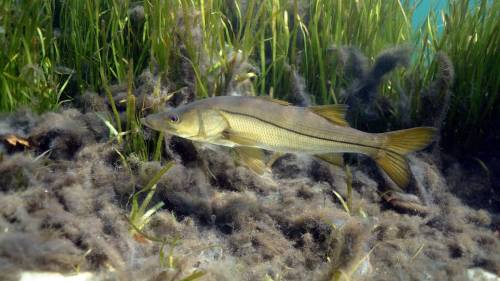
Allison Pease grew up fascinated by river fish, spending countless summers in a mask beneath the surface of Texas creeks. Now a fish ecologist in the College of Agriculture, Food and Natural Resources at the University of Missouri, Pease is studying the common snook — an iconic game fish that has filled an important cultural, ecological and economic niche in Mexico for centuries. Her latest study focuses on this species’ migration patterns and the effects of proposed hydrodams on their population in southern Mexico.
For the study, Pease traveled to the states of Tabasco and Chiapas, where she investigated the snook’s almost 400-mile migration up into the rainforest habitat of the Usumacinta River. She and colleagues have found that the snook, which connect aquatic food webs and support fisheries, spawn and start their lives in coastal nursery habitats before moving into river habitats that offer an array of food resources.

Using otolith microchemistry — the measuring of the chemical composition of the layers of bone that grow in a fish’s ear as it matures — Pease determined approximately where each snook had lived during its lifetime. This gave her insight into not only the snook’s migration patterns, but also whether the fish returned to the coast of the Gulf of Mexico to spawn or spent their adult lives in the river ecosystem.
“This is a fish that is important both culturally and economically, but it’s in danger of facing a collapse due to overharvesting,” Pease said. For instance, since the 1980s there have been recurring proposals to construct hydropower dams in this river system, which would restrict the migratory domain these fish currently occupy when they go up to 400 miles into the rainforest from the Gulf of Mexico. “The more we can understand what the fish needs and where it’s moving, the more we can inform conservation efforts in terms of identifying places to restrict harvest during certain times of the year to keep this fishery going.”
From Indigenous fisheries to commercial operations, snook have been celebrated as a high-quality river fish since the time of Mayan rule, making river fisheries in Mexico important for food, Pease said. She explained that diminishing environmental resources are spurring scientists to address the conservation of these historic fish to ensure their species’ protection.
“I suspect that because people really love this fish, they might be open to accepting some more conservative regulation,” Pease said. “The fisheries are mostly self-regulated with some places that have closures and limits on what kind of net you can use. We may need to strengthen some of those restrictions, if possible, to maintain the harvest of this fish.”
In the future, Pease hopes this research will not only advance the science of understanding how the common snook function — their migration patterns, habitat preferences and spawning sites — but also serve a critical role in informing fisheries conservation. With continuing environmental change, species that depend on many different connected habitats are often the most at risk of becoming endangered.
“Otolith microchemistry highlights the importance of extensive connectivity for conservation of an iconic migratory fish in a large tropical river basin” was recently published in Aquatic Conservation.